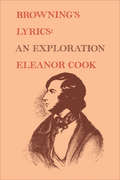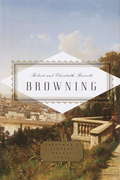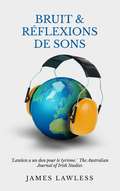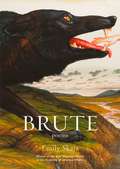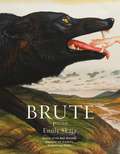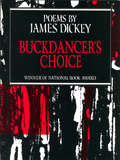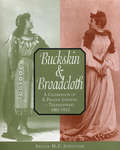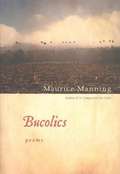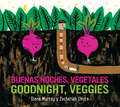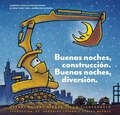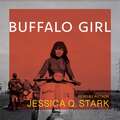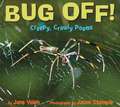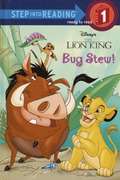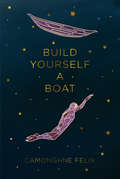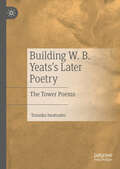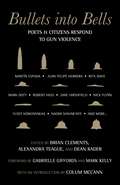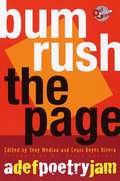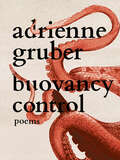- Table View
- List View
Browning's Lyrics: An Exploration
by Eleanor CookBrowning's lyrics are favourite choices for anthologies but are rarely examined closely. This is the first full-length study of the lyrics, and includes detailed analyses of such well-known poems as Love Among the Ruins, Two in the Campagna, A Serenade at the Villa, A Toccata of Galuppi's, By the Fireside, and James Lee's Wife. Eleanor Cook explores Browning's use of repeated images and themes in the lyrics, examines these patterns in other poems and in his letters, and analyses their growth and change in all his work. She demonstrates how the lyrics may be linked with Browning's other work and shows something of his essential artistic unity. His imaginary is found to be more consistent and complex than is usually assumed.Students of Browning will find this work stimulating and instructive, while lovers of Browning will read it with pure pleasure. The reader will return to many of the poems with a rciher sense of their continuing vitality. In an earlier form this study was awarded the first A.S.P. Woodhouse Prize by the University of Toronto.
Browning, Victorian Poetics and the Romantic Legacy: Challenging the Personal Voice (Ashgate Popular And Folk Music Ser.)
by Britta MartensTaking an original approach to Robert Browning's poetics, Britta Martens focuses on a corpus of relatively neglected poems in Browning's own voice in which he reflects on his poetry, his self-conceptualization and his place in the poetic tradition. She analyzes his work in relation to Romanticism, Victorian reactions to the Romantic legacy, and wider nineteenth-century changes in poetic taste, to argue that in these poems, as in his more frequently studied dramatic monologues, Browning deploys varied dramatic methods of self-representation, often critically and ironically exposing the biases and limitations of the seemingly authoritative speaker 'Browning'. The poems thus become devices for Browning's detached evaluation of his own and of others' poetics, an evaluation never fully explicit but presented with elusive economy for the astute reader to interpret. The confrontation between the personal authorial voice and the dramatic voice in these poems provides revealing insights into the poet's highly self-conscious, conflicted and sustained engagement with the Romantic tradition and the diversely challenging reader expectations that he faces in a post-Romantic age. As the Victorian most rigorous in his rejection of Romantic self-expression, Browning is a key transitional figure between the sharply antagonistic periods of Romanticism and Modernism. He is also, as Martens persuasively demonstrates, a poet of complex contradictions and an illuminating case study for addressing the perennial issues of voice, authorial authority and self-reference.
Browning: Poems
by Robert Browning Elizabeth Barrett Browning Peter WashingtonRobert Browning and Elizabeth Barrett Browning are without parallel in the nineteenth century: celebrated poets, they became equally famous for their marriage. Still popular more than a century after their deaths, their poetry vividly reflects the unique nature of their relationship.This collection presents the Brownings' work in the context of their lives: the early years and their initial friendship, their courtship and marriage, the fifteen happy years they spent living in Italy until Elizabeth's death. Whether in short poems such as Elizabeth's "Hector in the Garden" and Robert's "Natural Magic," or in extracts from longer works such as Aurora Leigh and Pauline, the great themes they shared are all represented: love, marriage, illicit passion, England and Italy, childhood, religion, poetry, and nature. Elizabeth's famous Sonnets from the Portuguese, based on their love affair, is included in its entirety. The poems are augmented with a generous selection of the marvelous letters the Brownings wrote to each other.
Bruit & Réflexions de sons
by James Lawless Leslie PierobonWhat noise? What will happen when it gets into our heads? In Thoughts of sounds, a hilarious history marked by pathos, James Lawless sends his typical humorous way some of the effects of noise on contemporary society. This news is followed by noise, a decidedly dark poem that explores the devastation that uncontrolled cacophony can inflict on sentient beings.
Brutal Imagination PA
by Cornelius EadyBrutal Imagination is the work of a poet at the peak of his considerable powers. Its two central sections--which could be called song cycles--confront the same subject: the black man in America. The first, which carries the book's title, deals with the vision of the black man in white imagination. Narrated largely by the black kidnapper that Susan Smith invented to cover up the killing of her two sons, the cycle displays all of Mr. Eady's range: his deft wit, inventiveness, and skillfully targeted anger, and the way in which he combines the subtle with the charged, street idiom with elegant inversions, harsh images with the sweetly ordinary. The second cycle, Running Man, presents poems Mr. Eady drew on for his libretto for the music-drama of the same name, which was a l999 Pulitzer Prize finalist. Here, the focus is the black family and the barriers of color, class, and caste that tear it apart. As the Village Voice said, It is a hymn to all the sons this country has stolen from her African- American families.
Brute
by Emily SkajaSelected by Joy Harjo as the winner of the Walt Whitman Award of the Academy of American Poets'Taut, ferocious . . . This is a book about survival, and a welcome, confident debut' New York Times Book ReviewEmily Skaja's debut collection is a fiery, hypnotic book that confronts the dark questions and menacing silences around gender, sexuality and violence. Brute arises, brave and furious, from the dissolution of a relationship, showing how such endings necessitate self-discovery and reinvention. The speaker of these poems is a sorceress, a bride, a warrior, a lover, both object and agent, ricocheting among ways of knowing and being known. Each incarnation squares itself up against ideas of feminine virtue and sin, strength and vulnerability, love and rage, as it closes in on a hard-won freedom.Brute is absolutely sure of its capacity to insist not only on the truth of what it says but on the truth of its right to say it. 'What am I supposed to say: I'm free?' the first poem asks. The rest of the poems emphatically discover new ways to answer. This is a timely winner of the Walt Whitman Award, and an introduction to an unforgettable voice.
Brute: Poems
by Emily SkajaSelected by Joy Harjo as the winner of the Walt Whitman Award of the Academy of American PoetsEmily Skaja’s debut collection is a fiery, hypnotic book that confronts the dark questions and menacing silences around gender, sexuality, and violence. Brute arises, brave and furious, from the dissolution of a relationship, showing how such endings necessitate self-discovery and reinvention. The speaker of these poems is a sorceress, a bride, a warrior, a lover, both object and agent, ricocheting among ways of knowing and being known. Each incarnation squares itself up against ideas of feminine virtue and sin, strength and vulnerability, love and rage, as it closes in on a hard-won freedom. Brute is absolutely sure of its capacity to insist not only on the truth of what it says but on the truth of its right to say it. “What am I supposed to say: I’m free?” the first poem asks. The rest of the poems emphatically discover new ways to answer. This is a timely winner of the Walt Whitman Award, and an introduction to an unforgettable voice.
Bubble Trouble
by Margaret MahyLittle Mabel blew a bubble, and it caused a lot of trouble... Such a lot of bubble trouble in a bibble-bobble way. For it broke away from Mabel as it bobbled across the table, where it bobbled over Baby, and it wafted him away. When little Mabel's bubble gets away from her, it's her baby brother who gets into trouble. Soon he's floating out of the house, above the fence, and all over town! It's up to Mabel, Mother, and the rest of the townspeople to get him safely back down. Who knew that so much trouble could come from one little bubble?
Buckdancer's Choice: Poems (Wesleyan Poetry Program #Vol. 28)
by James DickeyWhoever looks to a new book by James Dickey for further work in an established mode, or for mere novelty, is going to be disappointed. But those who seek instead a true widening of the horizons of meaning, coupled with a sure-handed mastery of the craft of poetry, will find this latest collection satisfying indeed.Here is a man who matches superb gifts with a truly subtle imagination, into whose depths he is courageously traveling--pioneering--in exploratory penetrations into areas of life that are too often evaded or denied. "The Firebombing," "Slave Quarters," "The Fiend"--these poems, with the others that comprise the present volume, show a mature and original poet at his finest.<P><P> Winner of the National Book Award
Buckskin and Broadcloth: A Celebration of E. Pauline Johnson — Tekahionwake, 1861-1913
by Sheila M.F. JohnstonThis is the first generously illustrated biography of the Mohawk poet-performer E. Pauline Johnson-Tekahionwake. The author has created an exciting volume of anecdotes, letters and poetry, and illustrated it with period photographs and new illustrations by the Six Nations artist, Raymond R. Skye. While the story of Pauline Johnson has been told before, it has never been given the intimacy that this book provides. Tracing her ancestry, moving on to explore her extraordinary stage career, and finally shedding light on Pauline Johnson’s last years in Vancouver, Sheila M.F. Johnston has breathed new life into the compelling story of one of Canada’s brightest literary and stage stars. This book contains over forty poems that are not part of Pauline Johnson’s classic collection of poems, Flint and Feather. The "uncollected" poems have been culled from archives, libraries and out-of-print books. They shed light on the development of the poet, and enlighten and enrich her life story. Buckskin & Broadcloth is truly a celebration of the life of a Canadian hero – one whose legacy to Canadian literature and Canadian theatre is unparalleled.
Bucolics
by Maurice ManningUntitled and unpunctuated, the seventy poems in this acclaimed collection seem to cascade from one page to another. Maurice Manning extolls the virtues of nature and its many gifts, and finds deep gratitude for the mysterious hand that created it all.that bare branch that branch made blackby the rain the silver raindrophanging from the black branchBoss I like that black branchI like that shiny raindrop Bosstell me if I'm wrong but it makesme think you're looking rightat me now isn't that a lark for meto think you look that wayupside down like a tree frogBoss I'm not surprised at allI wouldn't doubt it fora minute you're always upto something I'll say one thingyou're all right all right you areeven when you're hanging Boss
Bucolics (in English)
by VirgilAlso known as The Ecloques, this is the first of the three major works of the Latin poet Virgil.
Buenas Noches, Vegetales/Goodnight, Veggies Bilingual
by Diana MurraySay buenas noches to adorable garden veggies in this Spanish-English bilingual book, illustrated by New York Times best-selling artist Zachariah OHora.
Buenas noches, construcción. Buenas noches, diversión. (Goodnight, Goodnight, Construc)
by Sherri Duskey Rinker¡El libro #1 de la lista New York Times bestseller ahora disponible en español!Mientras se esconde el sol detrás del sitio de construcción, todas las máquinas trabajadoras se preparan para decir buenas noches. Una por una, Grúa, Mezcladora, Volquete, Niveladora y Excavadora terminan su trabajo y se acuestan a descansar—¡alistándose para otro día de construcción y diversion! Con ilustraciones irresistibles del reconocido artista Tom Lichtenheld y simpático texto en rima, este libro emocionará a todos los niños amantes de máquinas sin importar su edad.
Buffalo Girl (American Poets Continuum Series #199)
by Jessica Q. StarkIn these hybrid poems, Jessica Q. Stark explores her mother’s fraught immigration to the United States from Vietnam at the end of war through the lens of the Little Red Riding Hood fairy tale.Told through personal, national, and cultural histories, Buffalo Girl is a feminist indictment of the violence used to define and control women's bodies. Interspersed throughout this hybrid work are a series of collaged photographs, featuring Stark’s mother’s black-and-white photography from Vietnam beautifully and hauntingly layered over various natural landscapes — lush tropical plants, dense forests, pockets of wildflowers. Several illustrations from old Red Riding Hood children’s books can also be found embedded into these pieces. Juxtaposing the moral implications of Little Red Riding Hood with her mother's photography, Stark creates an image-text conversation that attends to the wolves lurking in the forests of our everyday lives. Opening the whispered frames around sexuality and sex work, immersed in the unflattering symptoms of survival, Buffalo Girl burgeons with matrilineal love and corporeal rage while censuring the white gaze and the violence enacted through the English language. Here is an inversion of diasporic victimhood. Here is an unwavering attention to the burdens suffered by the women of this world. Here is a reimagination, a reclamation, a way out of the woods.
Bug Off!: Creepy, Crawly Poems
by Jane Yolen Jason StempleIn Bug Off! readers meet thirteen bugs in playful, humorous poems and startling, intimate photographs. Nonfiction prose paragraphs broaden the perspective: Children will learn how bees make honey, that many butterflies can taste food with their feet, that lovebugs can fly higher than the Empire State Building, and much more. The subjects will be familiar to kids—a fly, praying mantis, honeybee, butterfly, daddy longlegs, lovebug, dragonfly, tick, ladybug, spider, grasshopper, ants, and a swarm of bugs—but the poems, photographs, and nonfiction passages present them in eye-opening new ways. Includes an author's note that encourages readers to write their own bug poems.
Bug Stew!
by Apple Jordan Robin CuddyIn this original story based on Disney's The Lion King, ever-hungry Timon and Pumbaa entice Simba to go on a fun bug hunt. Image Descriptions Added.
Build Yourself a Boat
by Camonghne Felix2019 National Book Award Longlist: &“Centering on black, female identity, [this is] an exquisite and thoughtful collection.&” —Bustle This is about what grows through the wreckage. This is an anthem of survival and a look at what might come after. A view of what floats and what, ultimately, sustains. A finalist for the PEN Open Book Award, Build Yourself a Boat redefines the language of collective and individual trauma through lyric and memory.&“With Build Yourself a Boat, Camonghne Felix heralds a thrillingly new form of storytelling.&” —Morgan Parker, author of Magical Negro
Building Poems
by Michael Clay ThompsonUses architecture as an extended metaphor, showing that poems are constructed like buildings and with careful attention to every detail
Building W. B. Yeats's Later Poetry: The Tower Poems
by Tomoko IwatsuboThis book explores Yeats’s later poetry through the metaphor of the poetic tower, where different kinds of ‘building’ – architectural, textual, political and symbolic – were closely interrelated. It chronologically examines Yeats’s tower poems, composed during a period of dramatic personal and national transformation, from 1915 to 1932. Within a year after the Easter Rising in Dublin, Yeats acquired a half-ruined Norman tower in County Galway, Ireland, which had enthralled him for the past two decades, and textually and architecturally constructed it into a focus of his life and work. Interweaving the account of the renovation of the actual building and the textual construction in the socio-historical contexts, the book reveals the evolution of Yeats’s multiplex tower as an organizing principle of his later poetry. Using the archive of correspondence and manuscript materials of relevant poems, including those which have thus far escaped close attention, the book offers close textual-genetic analyses and a diachronic view of Yeats’s tower poetry, which, with its foundations laid decades earlier, he built in the collections from The Wild Swans at Coole (1919) to The Winding Stair and Other Poems (1933). Highlighting the delicate exchange between poetry and biography as well as between the textual architecture and the actual one, identifying a turning point in the making of each tower-oriented poem and proposing some draft-dating revisions, this first book-length systematic study on the process of Yeats’s creation of the tower casts an unfamiliar light on a familiar yet underexplored landmark in modern poetry and makes his step-by-step construction work come alive.
Building a New Nation
by Elizabeth KearneyThis exciting collection of short stories, American folk tales, and poetry will take readers through many important historical events of America, from the westward expansion through the mid-20th century. Students will not only learn about Davy Crockett, Clara Barton, Abraham Lincoln, Booker T. Washington, and others; they will increase their reading comprehension and vocabulary through questions, activities, and word lists located at the end of most selections.
Bullets into Bells: Poets & Citizens Respond to Gun Violence
by Dean Rader Colum McCann Brian Clements Alexandra TeagueA powerful call to end American gun violence from celebrated poets and those most impactedFocused intensively on the crisis of gun violence in America, this volume brings together poems by dozens of our best-known poets, including Billy Collins, Patricia Smith, Natalie Diaz, Ocean Vuong, Danez Smith, Brenda Hillman, Natasha Threthewey, Robert Hass, Naomi Shihab Nye, Juan Felipe Herrera, Mark Doty, Rita Dove, and Yusef Komunyakaa.Each poem is followed by a response from a gun violence prevention activist, political figure, survivor, or concerned individual, including Nobel Peace Prize laureate Jody Williams; Senator Christopher Murphy; Moms Demand Action founder Shannon Watts; survivors of the Columbine, Sandy Hook, Charleston Emmanuel AME, and Virginia Tech shootings; and Samaria Rice, mother of Tamir, and Lucy McBath, mother of Jordan Davis.The result is a stunning collection of poems and prose that speaks directly to the heart and a persuasive and moving testament to the urgent need for gun control.
Bum Rush the Page: A Def Poetry Jam
by Tony Medina Louis Reyes RiveraBum Rush the Page is a groundbreaking collection, capturing the best new work from the poets who have brought fresh energy, life, and relevance to American poetry. "Here is a democratic orchestration of voices and visions, poets of all ages, ethnicities, and geographic locations coming together to create a dialogue and to jam--not slam. This is our mouth on paper, our hearts on our sleeves, our refusal to shut up and swallow our silence. These poems are tough, honest, astute, perceptive, lyrical, blunt, sad, funny, heartbreaking, and true. They shout, they curse, they whisper, and sing. But most of all, they tell it like it is." -Tony Medina, from the Introduction
Buoyancy Control
by Adrienne GruberBuoyancy Control, the latest collection of poems from Vancouverite Adrienne Gruber, explores themes of sexuality, sexual identity, and queerness, while confronting the feelings of loss and longing found in relationships, and the chance glimpse into a new life, while still recovering from a painfully failed connection.Metaphors of oceans, lakes, and other bodies of water, as well as the creatures that inhabit those spaces, swim and swirl their way through Gruber's languid poems, which are divided into two evocative sections. Though distinguished by their own prologue poems, both sections reveal details of the narrator's examination of life, but from two different perspectives: Section 1, Terra Firma, is an exploration of place, of what we consider solid and secure, and how solidity can betray us. In contrast, Section 2, A mari usque ad maria, brings the reader into themes of water and the fluidity of identity, particularly sexual identity and queerness.This is an honest, at times humorous, and revealing look inside the mind and body of a woman manoeuvring through experiences of longing, loss, and the fluidity of sexual identity, only to come out on the other side a more forgiving being from the journey. Fans of Karen Solie's powerfully feminist and unapologetic poetic voice, as well as the playful sarcasm and grit of Alison Calder's Wolf Tree, will glory in Gruber's fascinating culmination of land and sea, mind and body, in Buoyancy Control.
